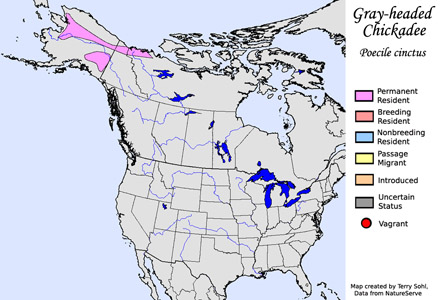| Length: 5.5 inches | Wingspan: 6.5 inches | Seasonality: Non-resident in South Dakota |
| ID Keys: Grayish-brown cap, small black bib, white face, grayish upperparts, light underparts, rusty flanks | ||
 The
Gray-headed Chickadee is the only member of the family that is found in both
the Old World and New World. In Europe and Asia, they are found from
Scandinavia, eastward across northern Europe and Asia. They are better
known as the "Siberian Tit" in their Eurasian range. In North America, their
geographic range is remote and populations are relatively small. They
are a prize species for birders in North America, a bird that most birders
will never see.
The
Gray-headed Chickadee is the only member of the family that is found in both
the Old World and New World. In Europe and Asia, they are found from
Scandinavia, eastward across northern Europe and Asia. They are better
known as the "Siberian Tit" in their Eurasian range. In North America, their
geographic range is remote and populations are relatively small. They
are a prize species for birders in North America, a bird that most birders
will never see.
Habitat: In their limited North American range, the Gray-headed Chickadee is found in stunted spruce forest, near treeline.
Diet: Feeds on insects, insect larvae, spiders, seeds, and nuts.
Behavior: Forages by clambering and flitting through the tree foliage in search of food. They may also fly out to grab insects from mid-air.
Nesting: The nest is in a cavity in a tree, either a natural cavity or an old woodpecker hole. The cavity is lined with bits of soft decaying wood, lichens, moss, and animal hair. The female lays between 6 and 9 eggs, and she alone incubates them. When the eggs hatch, both parents help feed the young. The young leave the nest after about 3 weeks.
Song: The song of Gray-headed Chickadees in North America isn't well known, but the song of the species in Eurasia is a series of rapid "che-ow" notes.
Migration: Considered a permanent resident throughout its normal range.
Interactive eBird Map: Click here to access an interactive eBird map of Gray-headed Chickadee sightings
Similar Species: Black-capped Chickadee, Boreal Chickadee
Feeders: In their Eurasian range, Gray-headed Chickadees will occasionally visit feeders for various seeds, nuts, and suet. Their range in North America is remote, with very low human populations, so feeder attendance in North America is unknown.
Conservation Status: Global populations are generally stable, and the species is found over a wide geographic region. The IUCN lists the Gray-headed Chickadee as a species of "Least Concern".
Further Information: 1) Alaska Fish and Wildlife News - The Quest for the Gray-headed Chickadee
2) Audubon Guide - Gray-headed Chickadee
3) Whatbird - Gray-headed Chickadee
Photo Information: Photo taken by Sergey Yeliseev - June 12th, 2012 - Republic of Altai in Russia - Photo licensed under Creative Commons Attribution NonCommercial NoDerivs 2.0 Generic License.
| Click below for a higher-resolution map |
 |
| South Dakota Status: Non-resident in South Dakota |
Additional Gray-headed Chickadee Photos (Coming soon!)
